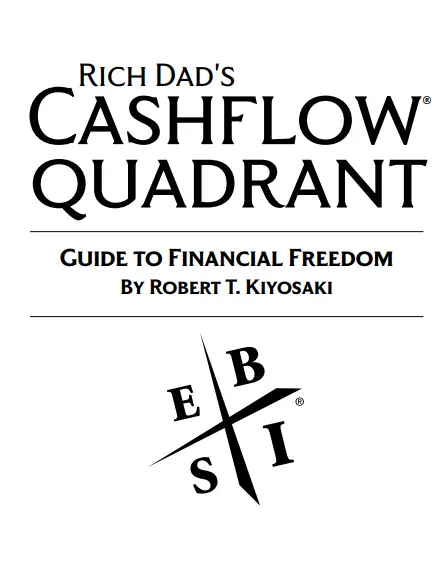
Rich Dad’s Cashflow Quadrant teaches how to move beyond traditional employment and build real wealth. Robert Kiyosaki explains the four income paths—Employee, Self-Employed, Business Owner, and Investor—and shows how to shift toward financial freedom. By building systems and investing in assets, you can make money work for you and break free from the paycheck trap.
Rich Dad’s Cashflow Quadrant is the follow-up to Robert Kiyosaki’s bestseller Rich Dad Poor Dad . In this book, he expands on the concept of financial independence and introduces a powerful model for understanding how people earn money and achieve financial freedom.
The central idea revolves around the Cashflow Quadrant , a framework that categorizes how individuals generate income:
Kiyosaki explains why people in the E and S quadrants often struggle financially and how moving into the B and I quadrants can lead to wealth, freedom, and financial independence .
This book is not just about making more money—it’s about changing your mindset, developing financial intelligence, and taking control of your financial future.
Kiyosaki divides income generation into four categories:
Employees work for a company, trading time for money. They seek job security and benefits but are often trapped in a paycheck-to-paycheck cycle.
“They trade hours for dollars—and their income stops when they stop working.”
Self-employed professionals like doctors, lawyers, consultants, or small business owners still trade time for money—just without a boss.
“They may make more than employees, but they work longer hours and have more stress.”
Business owners build systems that operate without their direct involvement. Their businesses generate income even when they’re not working.
“They create value through teams, systems, and scalable operations.”
Investors make money from money—through stocks, real estate, bonds, royalties, and other assets that generate passive income.
“Their money works for them, not the other way around.”
Key Insight: To become rich and achieve financial freedom, you must move from the left side (E & S) to the right side (B & I).
Most people spend their lives working in the Employee (E) or Self-Employed (S) quadrants because:
But Kiyosaki argues that working harder doesn’t necessarily make you richer—it just makes you busier.
“Working hard to save money won’t make you rich. You need to build wealth.”
He emphasizes that financial education is the key to transitioning to the B and I quadrants.
Important Lesson: Money alone won’t make you rich—your mindset and knowledge will.
Kiyosaki shows that while E and S roles are essential early in life, true financial freedom comes from mastering the B and I quadrants.
Kiyosaki outlines a clear path to escape the rat race and build lasting wealth:
Most people begin here. It’s okay—this is where you gain experience, discipline, and financial awareness.
Understand assets vs. liabilities, cash flow management, taxes, and investing. This is the foundation of wealth.
Don’t be self-employed forever. Build a systemized business that runs on its own—this moves you into the B quadrant.
Use your business profits to invest in assets that generate income without ongoing effort—this is the I quadrant.
Key Insight: The goal isn’t to quit your job—it’s to change how you think about money and work.
People who thrive in the B and I quadrants share certain traits:
“Poor people stay poor because they work for money. The rich make money work for them.”
Important Lesson: Financial freedom comes from mindset, not just income.
One of the most important lessons in the book is the difference between being self-employed (S) and owning a business (B) .
A real business:
Many entrepreneurs start as self-employed individuals and never scale beyond that.
“If you’re working IN your business every day, you’re not a business owner—you’re self-employed with a fancy title.”
Key Insight: A business should give you freedom—not bind you to it.
Kiyosaki offers practical steps to help readers shift toward the B and I quadrants :
Read books, attend seminars, and learn from mentors. Financial IQ is the foundation of wealth.
Instead of trading hours for dollars, invest time in learning how money grows.
You don’t need millions to start. Many great investors began with little—just a mindset shift.
Buy a franchise, start a network marketing business, or launch an online store—anything that teaches you how systems work.
Real estate, dividend stocks, royalties, and online businesses can generate income without constant labor.
Important Lesson: Wealth is built through assets, not income.
Kiyosaki shares stories of people who made the leap from E/S to B/I, including:
These examples reinforce that anyone can move to the right side of the quadrant with the right mindset and strategy.
Kiyosaki dives into how the wealthy legally reduce tax burdens using corporations and smart financial strategies.
He explains:
“The poor and middle class work hard, get taxed heavily, and grow poorer. The rich know how to play the game.”
This section encourages readers to think like investors and business owners , not just workers.
Rich Dad’s Cashflow Quadrant is more than a book about money—it’s a guide to changing your relationship with money .
It challenges readers to:
As Kiyosaki writes:
“The single most powerful asset we all have is our mind. If trained properly, it can create massive wealth.”